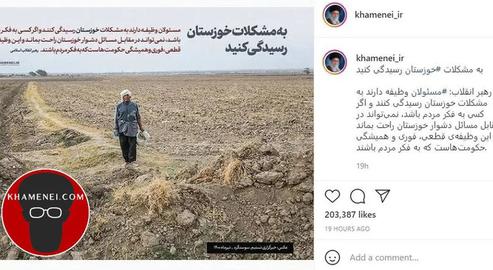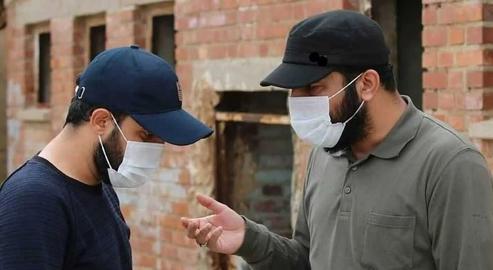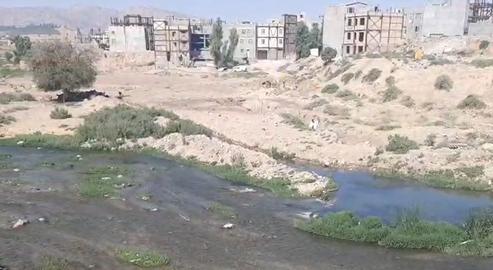In a bygone era, anyone sending a letter or petition to the rulers of Iran would enclose a gift to increase their chances of a favorable response. The message itself would feature the humble addendum: “Just to have something worthwhile in this petition, hereby a token is offered.”
A week after the eruption of demonstrations in Khuzestan, triggered by a long-brewing water crisis, and after his army of chain-brandishing motorcyclists, baton-wielding thugs and security forces gunned down, injured and arrested hundreds of citizens, the Supreme Leader of the Islamic Republic offered his own gift to the troops.
In a few lines on his official Instagram account, Khamenei quoted a five-year-old speech of his that had called on Iranian regime forces to “attend to Khuzestan’s problems”. This was followed by the news that – just to have something worthwhile – a troop of Shia eulogists known as the “Leader’s Soldiers” were on their way to Khuzestan.
***
On the fifth night of popular protests in Khuzestan, thousands again took to the streets to draw attention to years of neglect of their parched land. Against a backdrop of dying cattle, dusty riverbeds and running water reduced to a trickle, the night air was filled with a simple and plaintive cry: “We are thirsty!”.
There was something a little different about the fifth night, though. Wearing chadors and veils that covered their faces, a group of women came down to the streets and stood side-by-side with the protesters, who up until that point had been mostly young men.
A mother ululated for her son as he walked toward the gunmen, lined up on motorcycles on the other side of the road. Another woman strode toward the security forces herself, clutching her chador with one hand and shoving them backward with the other. “Go, go!” she yelled.
This is Khuzestan, a land still bearing the scars of an eight-year war with Iraq that ended more than three decades ago. In those years Khuzestan was on the front line, and much of its physical structures were never fully rebuilt.
Now it stands at the epicenter of a different kind of battle. The plains have subsided, aquifers and wetlands have dried up, and years of reckless agro-industrial development have laid waste to a once-fertile province’s natural resources. This time, the conflict is emanating from within.
In March 1997, Supreme Leader Ali Khamenei – who was president of Iran throughout the war years –travelled to Ahvaz, the provincial capital of Khuzestan, to deliver a speech on the “great bloody divine test” of the Iran-Iraq war.
“In [the Khuzestani city of] Susangerd,” he said, “I met a brave young Muslim woman. The people of Susangerd said that when the invading forces were in this city, she knocked down and destroyed few of the aggressors with her cane!”
Now in July 2021, the women of Khuzestan are again rising up to defend their homeland – but against their fellow, gun-wielding compatriots, dispatched to the province by none other than the Supreme Leader himself.
What Does Ali Khamenei Think of Khuzestan?
In all his years as Supreme Leader, Khamenei has rarely if ever mentioned Khuzestan in the context of anything other than the Iran-Iraq war. It usually comes as part of a broader point about resistance, heroism, or the damage the Iraqis inflicted on the citizenry.
There was one occasion on which Khamenei talked about Khuzestan’s internal affairs – but only as part of a wider game of political point-scoring. In March 2006 he visited Dehlaviyeh, a rural district west of Susangerd, to catch the Rahian-e Noor (“Passengers of Light”): a religious and political convoy of people of all ages who travel to visit war zones. They are organised by pro-government elements but the Islamic Republic often describes these caravans as “war tourism”.
In 2006, Mahmoud Ahmadinejad had been president of Iran for just under a year. “I thank god that the government now in charge is a government of action, a government of service,” Khamenei said in his speech to Dehlaviyeh residents. “This is what the people want: men who roll up their sleeves and serve them.
“In 1996, when I was in Khuzestan, I visited this same, vast area. I saw many places with my own eyes. And we sent out delegations to visit many other places. Had what we’d planned for Khuzestan been carried out effectively, there would now be much more ahead. But it’s still not too late.”
Khamenei knew well what had happened in Khuzestan, where between 60 and 100 percent of buildings in major cities had been damaged during the war. The “plans” he referred to had been actioned during the Mohammad Khatami administration, which Khamenei had neither liked nor supported.
With his blessing, President Ahmadinejad’s “government of action, government of service” was then tasked with new, drastic actions in Khuzestan – actions such as diverting water from the rivers to other parts of Iran, allowing Chinese oil drilling companies to lay waste to the wetlands, and aggressively building dams that would in turn deprive farmers of their livelihoods, and leave downstream communities thirsty.
In July 2021, a whole 15 years later, a woman in Khuzestan would tell the cameras that her child hadn’t had a drink of water for two days. A farmer would collapse on the floor of the municipality office, beating his head with both hands. Khamenei’s response to these people’s grievances has been to have them shot.
Praising Shia Saints and Suppressing Shia Protestors
Alongside a hail of bullets, Ali Khamenei has now deigned to send a band of famous – and well-renumerated – Shia eulogists to Khuzestan in a bid to bring the local population to heel through religious exhortation. “Your job is very important,” Khamenei told them before they were dispatched to the streets.
It was a strange tactic in one of Iran’s most ethnically and religiously diverse, multi-lingual regions. But not without precedent. On Ashura day in September 2019, at the same time as millions of Shia devotees were mourning the martyrdom of Imam Hussein, police vehicles rammed into a group of street protesters, killing a number of them.
A few days later on September 13, 2019, Hossein Sazvar, an ex-member of the IRGC and one of Iran’s best-known eulogists, unequivocally told Tasnim News Agency that his colleagues had also been involved in suppressing the protests.
“We were where we were supposed to be,” he replied. “It was around 10 or 10.30am that they brought in our delegation. It had become evident that we needed the power of Imam Hossein to defeat sedition, and it was defeated. I’d give my life to those who were beating their chests for Imam Hossein, saying that following the word of [Khamenei] was their duty.”
Another eulogist has stepped in to confirm the group’s dispatch to western Iran. “Today our duty lies in Khuzestan,” tweeted Meysam Motiee on the fifth night of the protests, adding that the Eid al-Ghadir displays planned for Tehran on Wednesday, July 28 had been moved to Khuzestan.
To date, Shia eulogists and other such “revolutionary managers” appointed by Khamanei have done nothing but make escalating situations worse – as they did in November 2019 and during uprisings in the preceding years.
Related Coverage:
Football Fans' Celebrations Turn Into Anti-Government Protests
More Arrests as Protests Intensify in Cities Across Iran
Anti-Government Protests Erupt in Tehran
Iran Protests: Grenade Launchers and Shotguns Used on Protesters
Khamenei Grooms Eulogists for Battle
Cyber Chaos: Khamenei's Address Raises Specter of New Internet Restrictions in Iran
Ali Khamenei's Addled Soundbites on the Water Crisis, Interrogated
Decades of Bribery and Mismanagement Lead to Khuzestan’s Protests
What Role has Ayatollah Khamenei Played in Iran's Blackouts?
visit the accountability section
In this section of Iran Wire, you can contact the officials and launch your campaign for various problems





























comments